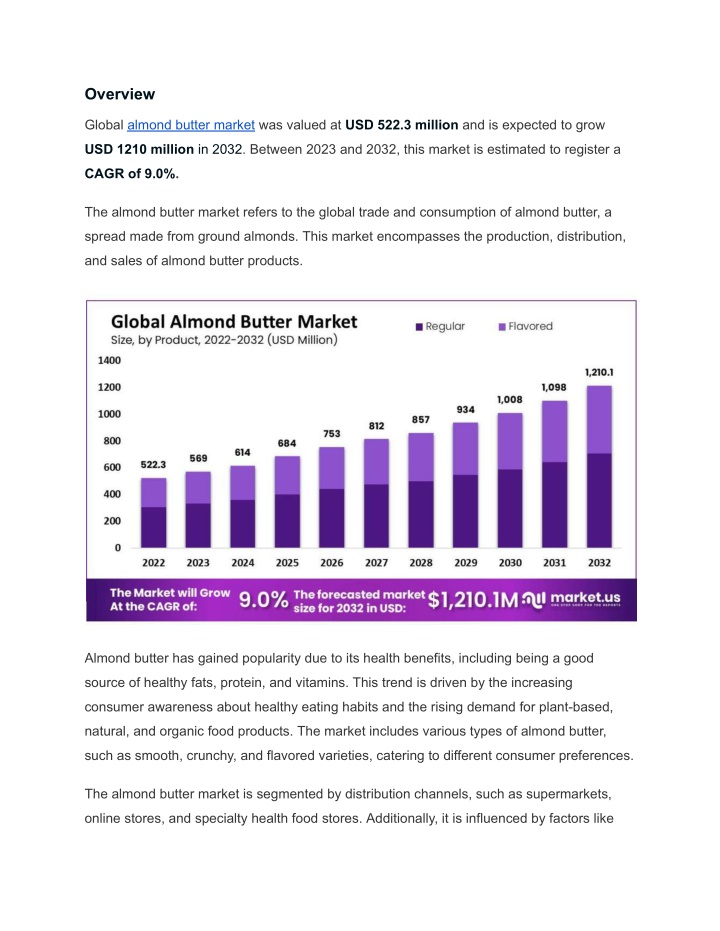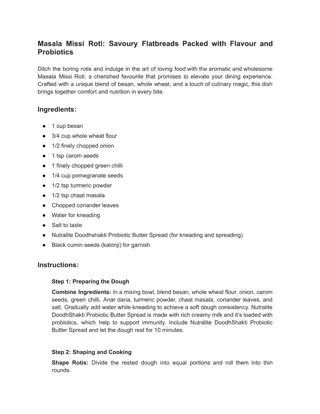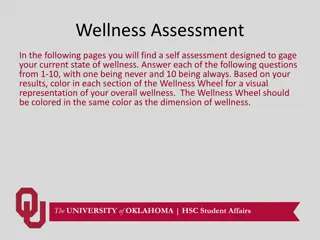
Almond Butter Market Opportunities in Health and Wellness Sector
Global almond butter market was valued at USD 522.3 million and is expected to grow USD 1210 million in 2032. Between 2023 and 2032, this market is estimated to register a CAGR of 9.0%.n
Download Presentation

Please find below an Image/Link to download the presentation.
The content on the website is provided AS IS for your information and personal use only. It may not be sold, licensed, or shared on other websites without obtaining consent from the author. If you encounter any issues during the download, it is possible that the publisher has removed the file from their server.
You are allowed to download the files provided on this website for personal or commercial use, subject to the condition that they are used lawfully. All files are the property of their respective owners.
The content on the website is provided AS IS for your information and personal use only. It may not be sold, licensed, or shared on other websites without obtaining consent from the author.
E N D
Presentation Transcript
Overview Global almond butter market was valued at USD 522.3 million and is expected to grow USD 1210 million in 2032. Between 2023 and 2032, this market is estimated to register a CAGR of 9.0%. The almond butter market refers to the global trade and consumption of almond butter, a spread made from ground almonds. This market encompasses the production, distribution, and sales of almond butter products. Almond butter has gained popularity due to its health benefits, including being a good source of healthy fats, protein, and vitamins. This trend is driven by the increasing consumer awareness about healthy eating habits and the rising demand for plant-based, natural, and organic food products. The market includes various types of almond butter, such as smooth, crunchy, and flavored varieties, catering to different consumer preferences. The almond butter market is segmented by distribution channels, such as supermarkets, online stores, and specialty health food stores. Additionally, it is influenced by factors like
price, quality, brand reputation, and innovative product offerings. Major players in the market are focusing on expanding their product lines and enhancing their distribution networks to capture a larger share of the growing demand. The market is also witnessing the entry of new, smaller brands that emphasize organic and non-GMO ingredients. Overall, the almond butter market is poised for steady growth, driven by the increasing popularity of healthy snacking and the broader trend towards natural and organic food consumption. Key Market Segments Based on Product Regular Flavored Based on Nature Organic Conventional Based on Distribution Channel B2B HoReCa Food & Beverage Processing Industry Personal Care & Cosmetic Industry B2C Hypermarkets & Supermarkets Convenience Stores Online Others Download a sample report in MINUTES@https://market.us/report/almond-butter-market/request-sample/
The almond butter market is divided by product type into regular and flavored varieties, with the regular segment holding the largest market share. By nature, the market is split into organic and conventional products. In 2022, the conventional segment dominated with an 89% market share. However, from 2022 to 2032, the organic segment is expected to grow at the fastest CAGR of 10.6%. Regarding distribution channels, the market is categorized into B2B and B2C segments. The B2B segment's growth is primarily driven by the increasing use of almond butter in the food and beverage processing industry, particularly in products like dips, sauces, and soups. Market Key Players Unilever Procter & Gamble The J.M. Smucker Hormel Foods Corporation Boulder Brands The Kraft Heinz Algood Food Co. Conagra Brands, Inc Britannia Dairy Private Limited Hormel Foods Corporation Justin s, LLC The Leavitt Corporation DiSano Alpino Pintola Other Key Players
Driving Factors: The increasing consumer desire for healthy food options and changing eating habits are boosting the global demand for almond butter. Its role as a healthy breakfast option and the shift towards diets that prevent cardiovascular disease and manage blood sugar levels are key drivers. Additionally, the innovation of using almond butter in cosmetics, due to its moisturizing and nourishing properties, and the rising demand for natural skincare products, are further propelling market growth. Restraining Factors: High production costs due to expensive raw materials and processing facilities can reduce profitability and market entry for new businesses. The market also faces challenges from the limited supply of raw materials, as fluctuations in almond crop yields can affect the cost and availability of almonds, potentially leading to shortages and higher prices. Growth Opportunities: Increasing consumer preference for healthy, natural food products and plant-based protein sources, along with heightened awareness of almond butter's health benefits, present significant growth opportunities. The expansion of e-commerce platforms has also enabled small and medium-sized producers to reach a larger audience, contributing to market growth. Trending Factors: Manufacturers are catering to evolving consumer tastes by introducing flavored almond butter, with varieties like cinnamon, vanilla, and chocolate gaining popularity. The convenience of purchasing almond butter online and the growing demand for organic and non-GMO products are also trending, driven by consumer interest in natural and organic foods.






















